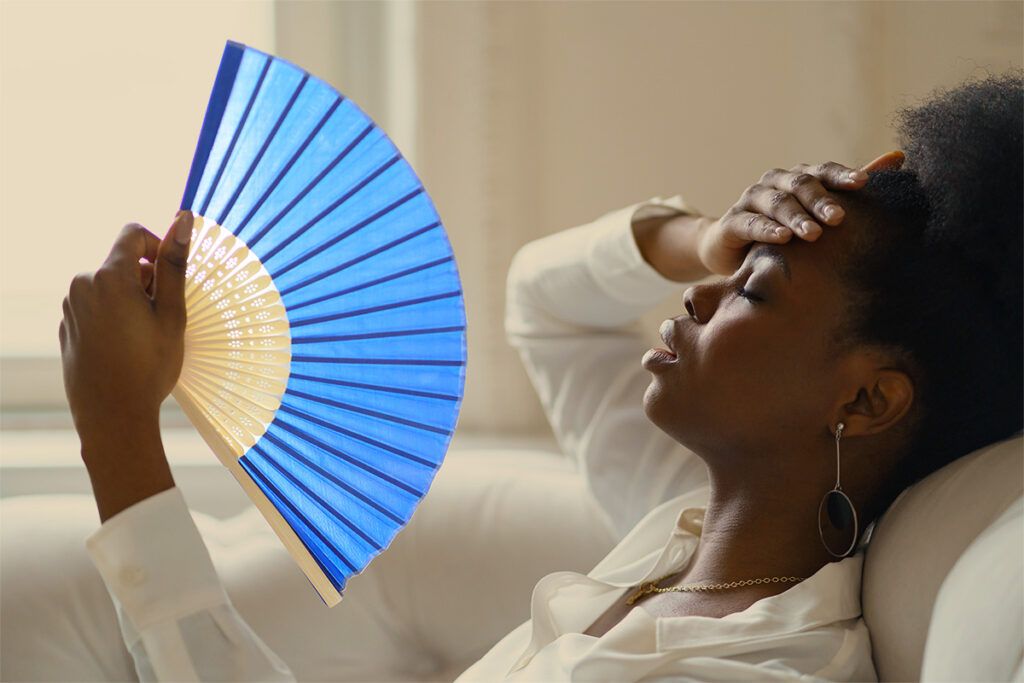Perspiration, night sweats, a sensation of intense heat coming from the inside of the body, a fast heartbeat, and a cold chill are all characteristics of a hot flash. You may also experience headaches, weakness, fatigue, faintness, and anxiety.
If you’re in your mid-40s and you notice these symptoms, you may be entering perimenopause — the years before menopause when hormonal changes start to happen. Hot flashes can begin in perimenopause and, in some cases, continue for several years after menopause.
You might also have hot flashes if you are taking hormonal therapies for cancer, have surgery to remove the ovaries, or have radiation therapy that affects the ovaries. Menopause due to medical treatment is called induced menopause, and it can occur at any age as long as the person is still in their reproductive years.
Hot flashes are one of the most common symptoms of menopause, but how they affect people can vary widely.
What causes hot flashes?

The exact cause of hot flashes is not entirely understood. But, they seem to appear when lower levels of the hormone estrogen change the way the body’s thermostat and vasomotor system work.
The vasomotor system uses special nerves to control the action of the blood vessels, and this affects blood flow.
The rapid fall in estrogen around menopause affects the body’s ability to regulate its own heat, leading to hot flashes, which doctors call vasomotor symptoms.
As a result, the body heats up. To dissipate this heat, the body increases blood flow to the skin’s surface. This can cause a red flushed face and perspiration. It can also affect the heart rate. A person may feel a cold chill after a hot flash.
Hot flashes are most likely to occur in the year before and the year after menopause. Menopause is when a person has had no periods for 12 months. In the United States, it occurs at the age of 52 years, on average.
Other causes
A range of medical conditions can also cause hot flashes, such as:
- some tumors
- hyperthyroidism
- acromegaly
Some medications can trigger hot flashes, such as:
- calcium channel blockers, used to lower blood pressure
- chemotherapy
- tamoxifen, a hormonal cancer treatment
- some antidepressants
- depo leuprolide (Leupron Depot), a hormonal therapy for endometriosis
If you have hot flashes that don’t seem to be due to menopause, it is a good idea to see a doctor.
Triggers
Hot flashes can happen for no apparent reason, but they can also occur in response to:
- a warm environment
- consuming hot drinks
- emotional stress
Risk factors
Some factors may lead to more severe or long lasting hot flashes.
They include:
It is unclear why people in some geographical areas, such as Turkey, are more likely to have hot flashes. Genetic factors may play a role.
Symptoms
The symptoms of hot flashes and their severity vary between individuals, but they include:
- intense heat sensation in the face and upper body
- redness on the face and neck
- red blotches on the arms, back, and chest
- sweating
- cold chills
- irregular heartbeat
- anxiety
- headache
- weakness
- fatigue
- faintness
- dizziness
Some people feel only a cold chill.
On average, hot flashes last up to 5 minutes, but this can vary. Their frequency and severity also vary. Some people have an occasional hot flash, some several times a week, and others 10 times a day.
Up to 74% of people have hot flashes during perimenopause. After menopause, 36% of people continue to have them for over 2 years and 36% for more than 5 years.
Prevention and treatment
Lifestyle choices and medications can help manage hot flashes.
Lifestyle choices include:
- avoiding alcohol, spicy foods, and caffeine
- avoiding or quitting smoking
- managing body weight
- wearing light clothes or dressing in layers that you can remove
- carrying a hand-held fan
- practice stress management techniques, such as meditation and deep breathing
Medications
Hormone therapy can help manage hot flashes by regulating estrogen and progesterone levels in the body. Examples include estradiol (Climara), a form of estrogen, and progesterone (Prometium).
Nonhormonal options include:
- antidepressants such as paroxetine (Paxil) and venlafaxine (Effexor)
- gabapentin (Neurontin) or pregabalin (Lyrica)
- clonidine (Catapres)
Supplements
Some people use natural or alternative remedies, such as black cohosh, phytoestrogens (which mimic the activity of estrogen in the body), and DHEA.
However, the National Institute on Ageing warns that these may be unsafe to use. It is best to speak with a doctor before trying them.
Get some tips for managing menopause symptoms.
If you need help covering the cost of medications, the free Optum Perks Discount Card could help you save up to 80% on prescription drugs. Follow the links on drug names for savings on that medication, or search for a specific drug here.
